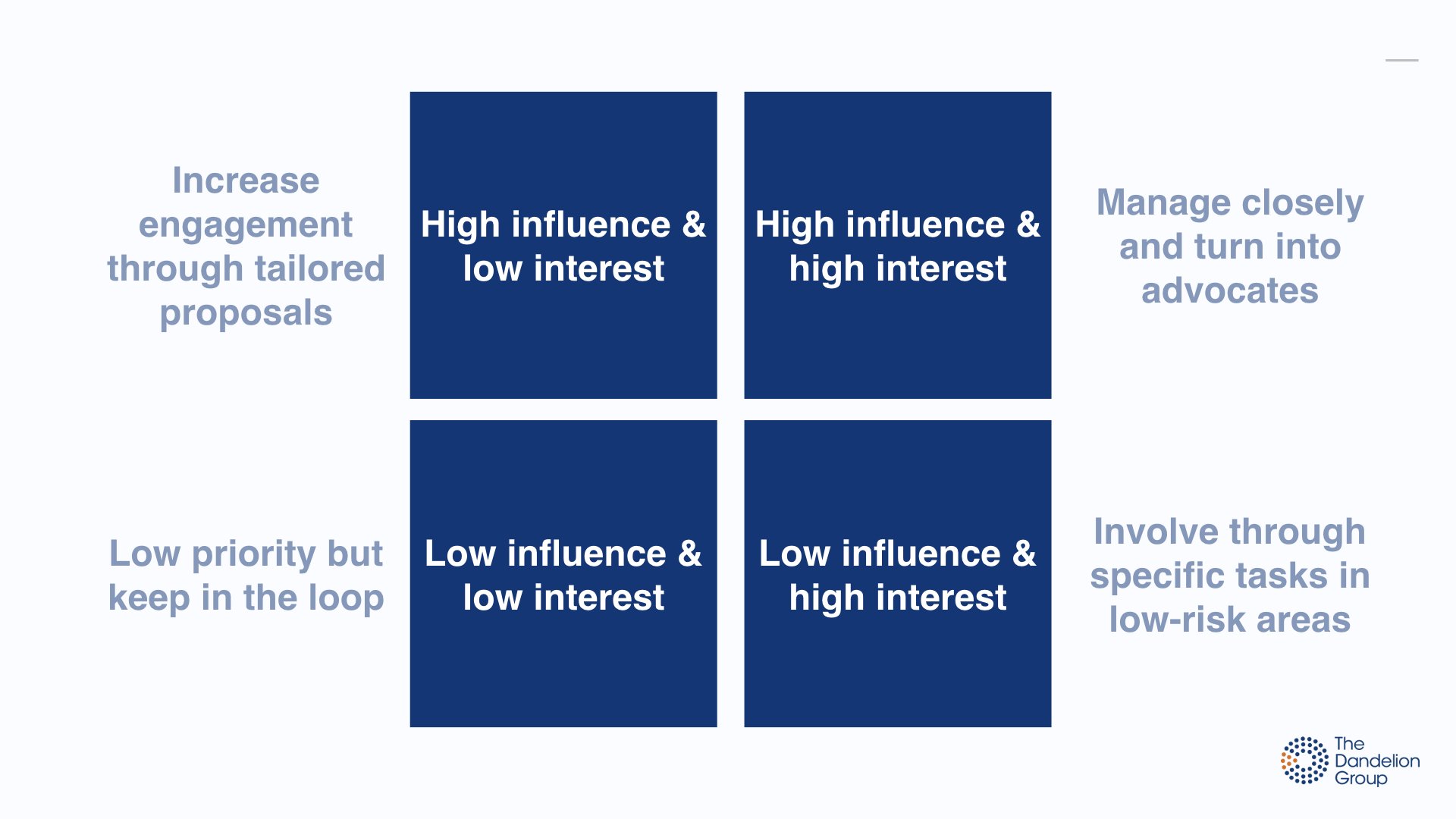Stakeholder engagement
Working with multiple partners does not have to be a multiple-alarm fire. How can we facilitate collaboration without burning out?
Influence and interest
There are only so many hours in a day. International organisations work with hundreds of partners who often send more than one representative. Understanding each stakeholder’s motivation requires a lot of time so your job, as a coordinator, is to look for ways to forge a pathway towards the final destination. Not everyone has to walk on this path to progress at the same pace or time.
You only know who you need if you have understood the context. S.W.O.T. and P.E.S.T.L.E. analyses are popular ways of analysing the environment. We recommend to S.C.O.P.E. out goals by answering these five questions:
Social: Why do stakeholders value us and what do they need?
Commercial: How sustainable is our current income and how can we maximise the benefits of our current operations?
Operational: How could our organisation’s priorities change, and why?
Political: Which developments lie ahead and how do we want to position ourselves vis-a-vis political institutions and parties?
Environmental: Which areas have shown the greatest improvement? How has and will innovation influence our project?
Getting a bird’s eye view first helps coordinators realise with whom they should really engage for the sake of efficiency (and their sanity). Do not focus automatically on the usual suspects. Prioritise partners according to their level of support as well their potential impact on goals you have set.
What are key stakeholders? They have a fundamental impact on your performance. We should be able to clearly identify what we want from them, and we should want the relationship to grow. The stakeholder should not have already been identified through another relationship and it should not be easy to replace them.
Views and conversations
Managing stakeholders is not easy because they work for different departments or even organisations. They have their own agenda and concerns yet there are fewer occasions to integrate views than with colleagues whom you meet every day. Nonetheless, the same conflicts can arise.
In case of discord, look for the cause. Indeed career coach Jennifer Herrity believes team conflicts result from incomplete tasks, leadership styles, work styles or personality clashes. Coordinators can thus consider adding items on team building to the agenda where partners figure out their own styles as well as discover the ones of others. We could also involve key stakeholders by inviting each one to lead on a task supported by someone from the core team.
Social scientists Joseph Grenny and Kerry Patterson recommend a new approach. It will not surprise you that many skip tough talks adding strain to serious situations. The fact that a team’s willingness or ability to hold a crucial conversation can predict a project’s success might surprise you, though. Grenny and Patterson’s studies further showed that “organisations save $1,500 and an eight-hour workday for every crucial conversation employees hold rather than avoid”.
How can we master tough talks? You will find plenty of memorable techniques in their book “Crucial Conversations”, yet one acronym stands out: S.T.A.T.E. Start by sharing your facts, telling your story and asking for the other’s view before moving on to talking tentatively with I- messages and encouraging a true dialogue.
Leadership and inspiration
Think about one of your hobbies.
Why are you pursuing it? Is it because somebody paid you to do it? Is it because somebody forced you to do it?
Carrots and sticks trigger temporary compliance but do not fuel lasting motivation. Driven by this discovery, Susan Fowler spent decades investigating what engages us. When you get frustrated because of an uncooperative stakeholder, remember the three factors she found: autonomy, relatedness and competence.
An engaged person participates out of their free will and contributes because they are under the impression that their voice is being heard. They care about others in the group and consider this feeling to be mutual. Lastly, they see opportunities to learn and show their skills. If you are facing a disinvolved stakeholder, turn to Fowler’s research to pinpoint why.
As soon as you know the main issues, you will find skilled allies in customer support and HR departments. We can strengthen the sense of autonomy by designing more inclusive meetings with liberating structures. Networking sessions can connect participants, and setting up a buddy system can make each one feel more competent. You do not have to search for solutions on your own but can also co-create solutions with your partners at a meeting.
Passive management does not fuel active engagement. American author John C. Maxwell proclaims that there are five levels ranging from a person’s position to the ultimate pinnacle based on an inspiring reputation. As coordinators, we have to accept that engaging stakeholders is a journey requiring us to pick the leadership styles that fit our key stakeholders best.
Three tips to engage stakeholders
Prioritise partners according to their influence and interest.
Resolve conflicts with the help of crucial conversations.
Motivate by fuelling autonomy, relatedness and competence.
- written by Benjamin Wilhelm, benjamin[at]thedandeliongroup.eu
Learn the techniques. Boost your confidence. Make your point.
Click here to unlock your potential.


